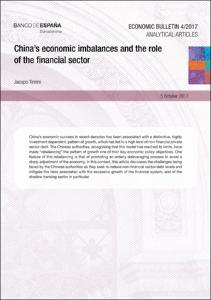Registro completo de metadatos
| Campo DC | Valor |
|---|---|
| dc.contributor.author | Timini, Jacopo |
| dc.coverage.spatial | China |
| dc.date.accessioned | 2019-08-14T07:41:45Z |
| dc.date.available | 2019-08-14T07:41:45Z |
| dc.date.issued | 2017-10-05 |
| dc.identifier.uri | https://repositorio.bde.es/handle/123456789/8914 |
| dc.description | Artículo de revista |
| dc.description.abstract | China’s economic success in recent decades has been associated with a distinctive, highly investment dependent, pattern of growth, which has led to a high level of non-financial private sector debt. The Chinese authorities, recognising that this model has reached its limits, have made “rebalancing” the pattern of growth one of their key economic policy objectives. One feature of this rebalancing is that of promoting an orderly deleveraging process to avoid a sharp adjustment of the economy. In this context, this article discusses the challenges being faced by the Chinese authorities as they seek to reduce non-financial sector debt levels and mitigate the risks associated with the excessive growth of the financial system, and of the shadow banking sector in particular |
| dc.format.extent | 9 p. |
| dc.language.iso | en |
| dc.relation.ispartof | Economic Bulletin / Banco de España, 4/2017 |
| dc.relation.hasversion | Versión en español 123456789/8293 |
| dc.rights | Reconocimiento-NoComercial-CompartirIgual 4.0 Internacional (CC BY-NC-SA 4.0) |
| dc.rights | In Copyright - Non Commercial Use Permitted |
| dc.rights.uri | https://creativecommons.org/licenses/by-nc-sa/4.0/deed.es_ES |
| dc.rights.uri | http://rightsstatements.org/vocab/InC-NC/1.0/ |
| dc.subject | Economía internacional |
| dc.subject | Análisis financiero |
| dc.title | China's economic imbalances and the role of the financial sector |
| dc.type | Artículo |
| dc.identifier.bdebib | 000361431 |
| dc.identifier.bdepub | ECBU-2017-4B-art29 |
| dc.subject.bde | Evolución y desarrollo económicos |
| dc.subject.bde | Sistema monetario y financiero. Situación y análisis |












